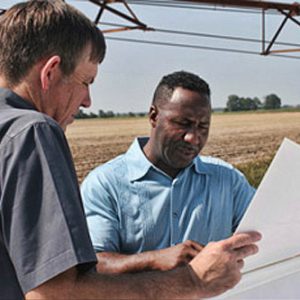calsfoundation@cals.org
Soil Conservation
Around 10,000 to 12,000 years ago, the first human inhabitants of what was to become the state of Arkansas could be characterized as scattered, small bands of hunter/gatherers who had little impact on the soil and water resources. Soil erosion that occurred was primarily due to natural events associated with dramatic post-glacial weather patterns. Human cultivation of Arkansas soils began around 3,000 years ago during the late Archaic Period when small patches of mostly squash, gourds, sunflowers, beans, and, later, corn were cultivated. Early crop cultivation did not appear to harm the soil and water resources due to the small size of the gardens and the relatively low density of human inhabitants in the region. As human population increased, so did the culture of crops and demand for tillage of arable land. The population of the area that became Arkansas swelled with European migration in the 1800s, which hastened the clearing of woodlands for the planting of crops and pasture for livestock. Agriculture soon became the number-one industry of the state as the settlers discovered rich top soils and favorable climates for crop production. Acreage cleared for crops increased dramatically during the 1920s and 1930s, especially in the rich alluvial soils of eastern Arkansas where cotton, oats, rice, and corn were the main crops.
Over-cultivation of the Great Plains prairie soils and a period of abnormally dry and windy weather in the late 1920s and 1930s caused major dust storms across the eastern United States, dubbed the Dust Bowl. The nation soon realized that soil and water resources were of vital national interest and necessary for economic stability. The U.S. Congress passed the Buchanan Amendment to the Agricultural Appropriation Bill in 1930, which allocated $160,000 for the establishment of ten soil-erosion and ten plant material experiment stations. In the 1932 Yearbook of Agriculture, Hugh Hammond Bennett, a leading proponent of soil conservation, stated that erosional wastage had become a gravely important American economic problem. In 1933, the U.S. Department of the Interior established the Soil Erosion Service as a temporary public works program with Bennett as director. The Soil Erosion Service contracted with local governments to establish vegetation on eroded soils and construct erosion-control dams.
In 1935, the temporary Soil Erosion Service became the Soil Conservation Service, a permanent agency in the U.S. Department of Agriculture. Early work by this agency was focused on restoration of erosion-impacted lands. Under Bennett’s leadership, the Standard State Soil Conservation Districts Law was enacted in 1937 to establish local districts in each state to provide guidance on soil conservation activities. In response, the Arkansas General Assembly passed Act 197 of 1937, which provided for the creation of local conservation districts to serve the soil and water conservation needs of the people. Today, each county conservation district has five directors who serve without pay and meet once a month to address matters related to local soil and water conservation needs. A State Soil Conservation Committee was formed to assist in the organization of the districts and provide training to district directors. Act 14 of 1963 created the Arkansas Soil and Water Conservation Commission (ASWCC), today consisting of nine members appointed by the governor with advice from the Arkansas Senate. The ASWCC was renamed the Arkansas Natural Resources Commission (ANRC) in 2005 with the stated mission: “To manage and protect our water and land resources for the health, safety and economic benefit of the state of Arkansas.” The ANRC oversees the county districts and elects two of the five county directors; the other three directors are elected by local land owners.
Early soil conservation work in Arkansas was devoted to remediation of erosion-impacted areas, like gullies, that had formed from poor land management practices. In the 1940s, many acres of hilly, erosive soils were still being cultivated for crops such as cotton using tillage systems that left little residue on the surface to protect the fragile topsoil. As the topsoil layers washed away, crop yields suffered due to exposure of poorer sub-soil layers in the active root zones of crops, and the soil sedimentation in streams increased flooding and was detrimental to the natural ecosystems. Conservation work in the 1950s was devoted mostly to construction of broadbase terraces, runoff catchment dams, and vegetated waterways, as well as establishment of pastures and woodlands on marginal soils and the design and construction of flood control structures and irrigation canals. The price of soybeans soared in the late 1960s to early 1970s, and farmers began to till and plant soybeans on erosion-susceptible soils in some areas of the state. Soil and water conservation efforts in the 1970s and 1980s encouraged the implementation of soil-saving no-till and conservation tillage systems, as well as the return of tilled, erosive soils back to less erosive pasture and woodland uses. The Soil Conservation Service provided free technical services, and several government cost-share programs helped local districts and landowners obtain financial assistance for the implementation of soil and water conservation practices.
In 1994, the name of the Soil Conservation Service was changed to the Natural Resources Conservation Service (NRCS) to reflect the more comprehensive role of the agency. Current soil and water conservation efforts in Arkansas are cooperative efforts among federal, state, local, and private entities and may involve water conservation and quality improvement, wildlife habitat improvement, recreational uses, water control and irrigation improvement, wetland restoration, urban soil erosion and water quality improvement, land-application of animal manures, groundwater conservation, waste disposal, stream restoration and conservation, and many more projects to improve the management of the state’s most valuable commodities—the soil and water resources.
For additional information:
Arkansas Natural Resources Commission. http://www.anrc.arkansas.gov/ (accessed April 12, 2022).
Brady, N. C., and R. R. Weil. The Nature and Properties of Soils. 14th ed. Columbus, OH: Pearson/Prentice Hall, 2008.
Roberts, R. W., ed. Arkansas Natural Resources—Their Conservation and Use. Little Rock: Democrat Printing and Lithographing Company, 1942.
Soil Survey Division Staff. Soil Survey Manual. U.S. Department of Agriculture Handbook 18. Washington DC: Soil Conservation Service, 2003.
Paul B. Francis
University of Arkansas at Monticello
 Camp Halsey
Camp Halsey Reed, Pearlie Sylvester
Reed, Pearlie Sylvester Roots, Logan Holt
Roots, Logan Holt Irrigation Systems
Irrigation Systems  Wetland Planning
Wetland Planning 




Comments
No comments on this entry yet.